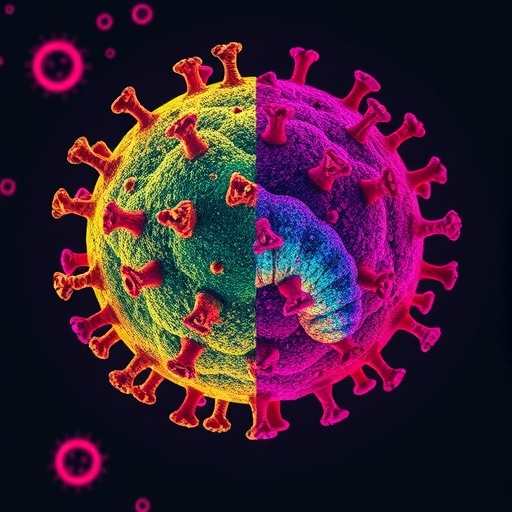The emerging landscape of COVID-19 has revealed a stark contrast in how the virus manifests across different age groups, particularly highlighting a unique and alarming phenotype in children. Unlike adults, the pediatric population infected with Severe Acute Respiratory Syndrome Coronavirus 2 (SARS-CoV-2) has shown susceptibility to distinctive inflammatory syndromes that were previously uncharacterized before the pandemic. Chief among these conditions are Multisystem Inflammatory Syndrome in Children (MIS-C) and Pediatric Inflammatory Multisystem Syndrome Temporally Associated with SARS-CoV-2 (PIMS-TS), both of which have redefined the clinical understanding of pediatric COVID-19 and its complications.
While the respiratory symptoms of COVID-19 have dominated the early narratives of the disease, it has become increasingly clear that the virus’s impact stretches far beyond the lungs. The pediatric population, once thought to be relatively spared from severe outcomes, has presented with significant neurological manifestations that raise concerns about the short- and long-term effects of SARS-CoV-2 on the developing nervous system. These neurological symptoms range from subtle cognitive disturbances to severe inflammatory processes that affect brain function, reflecting a complex neurobiological response to viral infection and the host immune reaction.
The neurodevelopmental consequences of both acute COVID-19 infection and post-infectious inflammatory syndromes such as MIS-C/PIMS-TS in children remain critically underexplored. A growing body of evidence indicates the nervous system’s vulnerability during critical periods of brain development, especially when confronted with systemic inflammatory insults triggered by SARS-CoV-2. This points to a potentially troubling legacy of the pandemic—neurological sequelae that could impair children’s cognitive outcomes and quality of life long after recovery from the initial infection.
At the molecular level, the pathophysiology underlying SARS-CoV-2 neurovirulence is intricate and multifactorial. The virus’s ability to engage receptors such as angiotensin-converting enzyme 2 (ACE2), expressed not only on respiratory epithelial cells but also on neurons and glial cells, hints at direct neuroinvasion routes. However, much of the neurodamage observed in pediatric cases appears to be driven not solely by viral replication within neural tissue, but also by dysregulated immune responses causing widespread neuroinflammation and endothelial dysfunction, ultimately leading to blood-brain barrier disruption and neuronal injury.
Immunopathology plays a pivotal role in this context. The cytokine storm triggered during MIS-C/PIMS-TS unleashes a barrage of pro-inflammatory mediators, elevating levels of interleukins and tumor necrosis factors that infiltrate the central nervous system (CNS), thereby precipitating encephalopathy, seizures, and other neurological symptoms. Investigating the dynamics of this hyperinflammatory state is crucial for understanding how pediatric SARS-CoV-2 infection translates into neurological impairments.
Despite the growing recognition of these neurological effects, epidemiological data remain scant and fragmented. Current studies report variable prevalence of CNS symptoms among children with COVID-19, with manifestations including headaches, encephalitis, neuropsychiatric disturbances, and peripheral neuropathies. The heterogeneity of these presentations complicates early diagnosis and obscures the long-term prognosis, underscoring the urgent need for comprehensive, longitudinal research to delineate the full spectrum of neurologic sequelae.
An ongoing challenge is the differentiation between direct viral encephalitis and post-infectious autoimmune phenomena mimicking disorders such as acute disseminated encephalomyelitis (ADEM). This diagnostic uncertainty hampers effective therapeutic interventions and calls for enhanced neuroimaging protocols combined with molecular assays capable of detecting viral RNA and inflammatory biomarkers within the cerebrospinal fluid.
From a clinical perspective, the management of these pediatric neurological complications demands multidisciplinary approaches involving neurologists, immunologists, and critical care specialists. Treatment paradigms often include immunomodulatory therapies such as intravenous immunoglobulins (IVIG), corticosteroids, and biologics targeting specific inflammatory pathways. Early intervention, supported by vigilant neurological monitoring, could mitigate the risk of lasting cognitive and developmental deficits in affected children.
The potential long-term neurodevelopmental impact of COVID-19 and related inflammatory syndromes represents a public health concern of unprecedented scale. The developing brain’s plasticity and vulnerability necessitate follow-up strategies embracing neuropsychological assessments, educational support, and rehabilitative services tailored to individual needs. Moreover, insights into the virus-derived neurotoxicity may inform preventative measures, including vaccination strategies optimized for children.
At the research frontier, unraveling SARS-CoV-2’s neuropathogenic mechanisms is paramount. Animal models and in vitro studies using neural cell cultures serve as pivotal tools for elucidating viral behavior within the CNS. Moreover, advances in neuroimmunology and neurovirology promise to uncover novel therapeutic targets to counteract neuroinflammation and preserve neurocognitive functions in pediatric patients.
Concurrently, public health messaging must incorporate updated scientific knowledge regarding pediatric COVID-19 neurological risks, combating misinformation and fostering community awareness. Empowering caregivers and healthcare providers with this information facilitates earlier recognition of symptoms, timely medical attention, and adherence to protective measures reducing exposure among children.
Impressively, vaccine campaigns have influenced the trajectory of pediatric COVID-19 outcomes, yet concerns persist regarding vaccine efficacy against emerging variants and their role in preventing MIS-C and neuroinflammatory complications. Consequently, continuous vaccine safety monitoring and efficacy studies in children remain integral to controlling the neuropsychological burden attributed to SARS-CoV-2.
Intriguingly, parallels between SARS-CoV-2 neurological impact and other neurotropic viruses invite comparative studies that could broaden understanding of virus-host CNS interactions. Such investigations may reveal conserved pathogenic pathways exploitable for broad-spectrum antiviral and neuroprotective interventions applicable beyond the current pandemic.
In conclusion, the neurological and neurodevelopmental aftermath of SARS-CoV-2 infection and its associated inflammatory syndromes pose complex challenges for pediatric health. Comprehensive research efforts, coupled with proactive clinical and public health strategies, are essential for unraveling and mitigating the neurobiological consequences that may shape a generation of young survivors. As science continues to illuminate this enigmatic facet of COVID-19, the imperative to safeguard the developing brain becomes ever more critical.
Subject of Research: Neurological and neurodevelopmental effects of COVID-19 and Multisystem Inflammatory Syndrome in Children (MIS-C) associated with SARS-CoV-2 infection.
Article Title: Neurological and neurodevelopmental effects of Covid and MIS-C on children.
Article References:
Byrne, D., Gale, C., Canty, N. et al. Neurological and neurodevelopmental effects of Covid and MIS-C on children. Pediatr Res (2025). https://doi.org/10.1038/s41390-025-04564-2
Image Credits: AI Generated
DOI: 11 November 2025




